Q. Consider the following statements
- Carbon fibres are used in the manufacture of components used in automobiles and aircrafts.
- Carbon fibres once used cannot be recycled.
Which of the statements given above is fare correct?
(a) 1 only
(b) 2 only
(c) Both 1 and 2
(d) Neither 1 nor 2
Answer: (a) 1 only
Carbon fibre
- Carbon fibers can be defined as fibers with a carbon content of 90% or above. They are produced by thermal conversion of organic fibers with a lower carbon content such as polyacrylonitrile (PAN) containing several thousand filaments with diameter between 5 and 10 μm.
- The main advantage of carbon fibers compared to other fibers are the high tensile strength, high stiffness, low density, and a high chemical resistance.
- Carbon fibre is increasingly celebrated as a wonder material for the clean economy. Its unique combination of high strength and low weight has helped drive the wind power revolution and make planes more fuel efficient. Auto makers are also waking up to the material’s potential to make lighter and more efficient vehicles.
- The carbon fibre can be recycled though difficult to recycle. There is need to divert carbon fibre from landfill, they could open the gates for use of recycled carbon fibre in cars, bikes and for dozens of other applications. They could also save a lot of energy, since the production of virgin material is the most energy-intensive part of the process. Recycled carbon fibre often ends up in tennis rackets and golf clubs, where low weight (and the cachet of carbon fibre) is more important than strength.
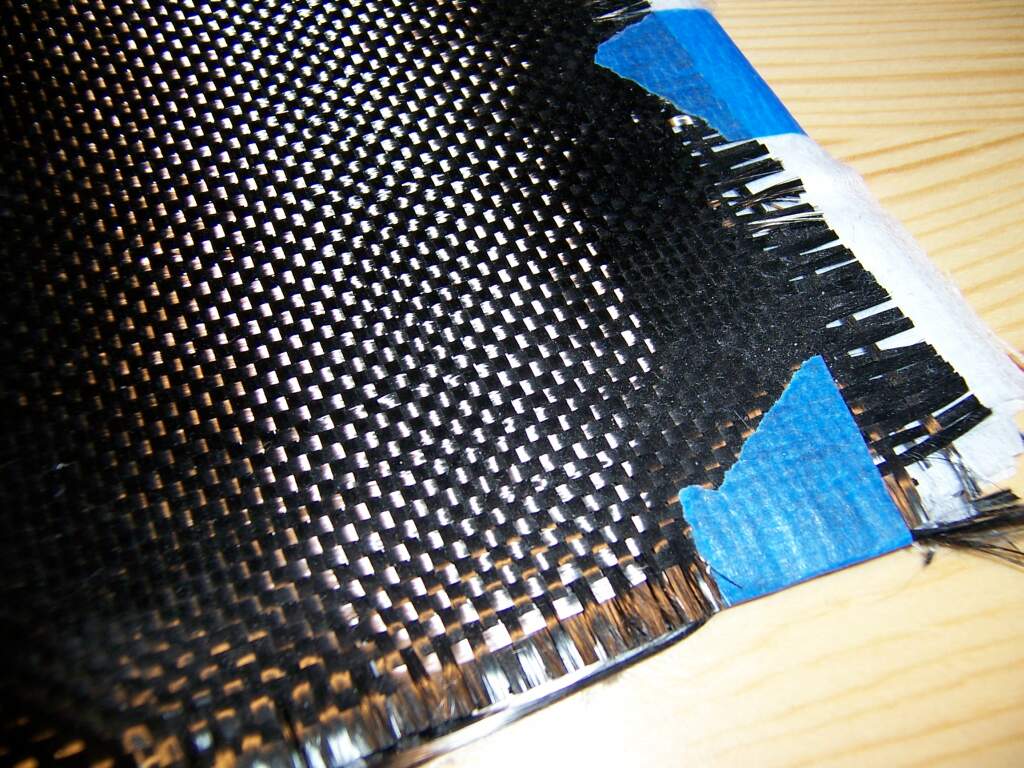
Q. Consider the following actions :
- Detection of car crash/ collision which results in the deployment of airbags almost instantaneously
- Detection of accidental free fall of a laptop towards the ground which results in the immediate turning off of the hard drive
- Detection of the tilt of the smartphone which results in the rotation of display between portrait and landscape mode
In how many of the above actions is the function of accelerometer required?
(a) Only one
(b) Only two
(c) All three
(d) None
Answer: (c) All three
Accelerometers
- Accelerometers are devices that measure the vibration, or acceleration of motion of a structure. They have a transducer that converts mechanical force caused by vibration or a change in motion, into an electrical current using the piezoelectric effect.
- Any reliable car crash detection system requires an accelerometer that can measure up to several hundreds of g-force accelerations. In the event of a crash, the crash sensor (an accelerometer) sends a signal to the airbag control unit. This control unit triggers the inflation device, which generates nitrogen gas by igniting a mixture of sodium azide (NaN3) and potassium nitrate (KNO3).
- Accelerometers in laptops protect hard drives from damage. If the laptop were to suddenly drop while in use, the accelerometer would detect the sudden free fall and immediately turn off the hard drive to avoid hitting the reading heads into the hard drive platter.
- An accelerometer detects acceleration, vibration, and tilt to determine movement and exact orientation along the three axes. Apps use this smartphone sensor to determine whether your phone is in portrait or landscape orientation. It can also tell if your phone screen is facing upward or downward.

Q. Consider the following pairs :
Objects in space : Description
- Cepheids Giant clouds of dust and gas in space
- Nebulae Stars which brighten and dim periodically
- Pulsars Neutron stars that are formed when massive stars run out of fuel and collapse
How many of the above pairs are correctly matched?
(a) Only one
(b) Only two
(c) All three
(d) None
Answer: (a) Only one
Notes:
Cepheids
- Cepheids, also called Cepheid Variables, are stars which brigthen and dim periodically. This behavior allows them to be used as cosmic yardsticks out to distances of a few tens of millions of light-years. The brighter the Cepheid, the longer its period.
- In fact, Cepheids are very special variable stars because their period (the time they take to brighten, dim and brighten again) is regular (that is, does not change with time), and a uniform function of their brightness. That is, there is relation between the period and brightness such that once the period is known, the brightness can be inferred.
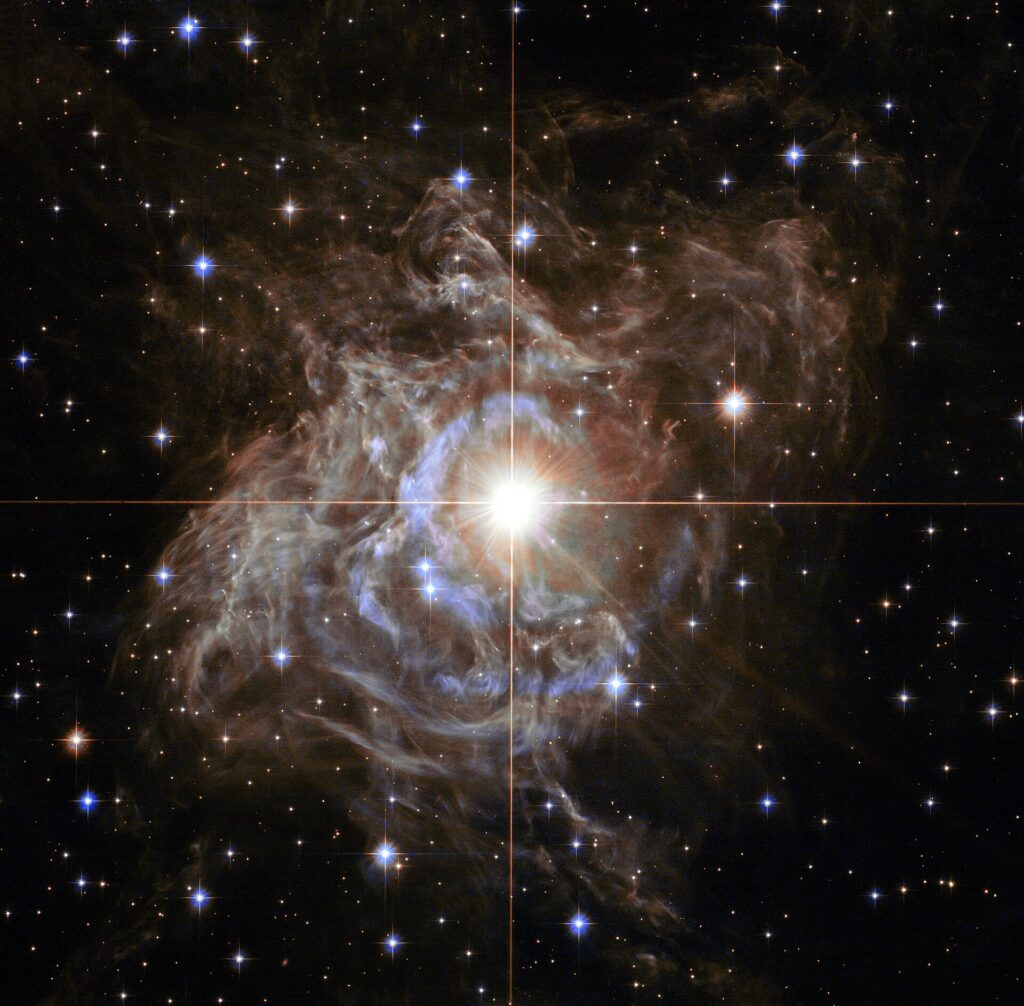
Nebula
- A nebula is a giant cloud of dust and gas in space. Nebula is a distinct luminescent part of interstellar medium, which can consist of ionized, neutral, or molecular hydrogen and also cosmic dust.
- Some nebulae (more than one nebula) come from the gas and dust thrown out by the explosion of a dying star, such as a supernova. Other nebulae are regions where new stars are beginning to form. For this reason, some nebulae are called “star nurseries.”
- There are different kinds of nebulae based on their appearance {such as dark nebulae, reflection nebulae and planetary nebulae} or the physical processes that create them {such as protostellar nebulae, protoplanetary nebulae, or supernova remnants}.
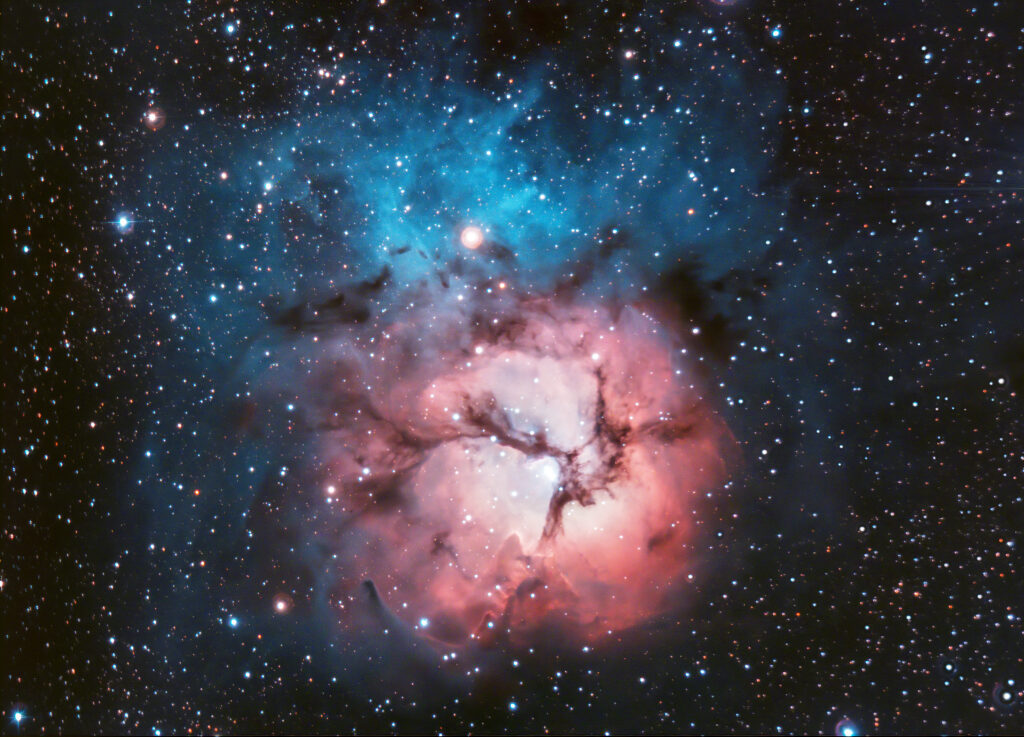

Pulsars
- Pulsars are neutron stars. Pulsars are rotating neutron stars observed to have pulses of radiation at very regular intervals that typically range from milliseconds to seconds. A pulsar is the crushed core of a massive star that ran out of fuel, collapsed under its own weight and exploded as a supernova.
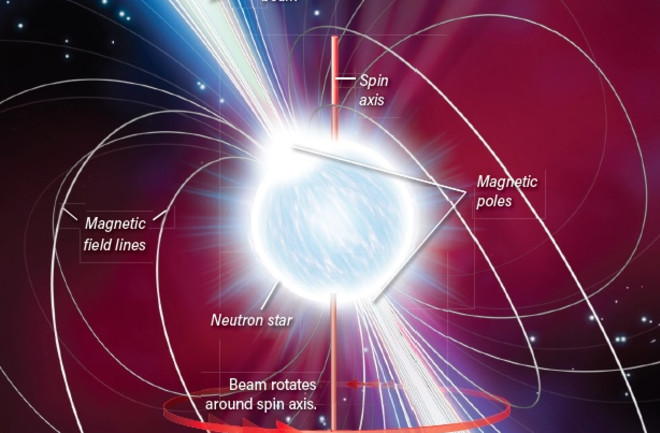
Quasar
- Quasar refers to quasi-stellar radio source. They were thought to be stars earlier but they are not stars at all, but rather active galactic nuclei.
- Nowadays, the word “quasar” is often used to mean any Quasi-Stellar Object (QSO), whether or not it emits radio waves.
James Webb Space Telescope
- The telescope is the result of an international collaboration between NASA, the European Space Agency (ESA) and the Canadian Space Agency which was launched in December 2021.
- It is currently at a point in space known as the Sun-Earth L2 Lagrange point, approximately 1.5 million km beyond Earth’s orbit around the Sun.
- Lagrange Point 2 is one of the five points in the orbital plane of the Earth-Sun system.
- Named after Italian-French mathematician Josephy-Louis Lagrange, the points are in any revolving two-body system like Earth and Sun, marking where the gravitational forces of the two large bodies cancel each other out.
- Objects placed at these positions are relatively stable and require minimal external energy or fuel to keep themselves there, and so many instruments are positioned here.
- It’s the largest, most powerful infrared space telescope ever built.
- It’s the successor to Hubble Telescope.
- It can see backwards in time to just after the Big Bang by looking for galaxies that are so far away that the light has taken many billions of years to get from those galaxies to our telescopes.
- Objectives:
- It will examine every phase of cosmic history: from the Big Bang to the formation of galaxies, stars, and planets to the evolution of our own Solar System.
- The goals for the Webb can be grouped into four themes.
- The first is to look back around 13.5 billion years to see the first stars and galaxies forming out of the darkness of the early universe.
- Second, to compare the faintest, earliest galaxies to today’s grand spirals and understand how galaxies assemble over billions of years.
- Third, to see where stars and planetary systems are being born.
- Fourth, to observe the atmospheres of extrasolar planets (beyond our solar system), and perhaps find the building blocks of life elsewhere in the universe.
Q. Which one of the following countries has its own Satellite Navigation System?
(a) Australia
(b) Canada
(c) Israel
(d) Japan
Answer: (d) Japan
Satellite Navigation System
- Global navigation satellite system (GNSS) is a general term describing any satellite constellation that provides positioning, navigation, and timing (PNT) services on a global or regional basis.
- There are totally four Global Navigation Satellite System (GNSS) available. They are GPS (US), GLONASS (Russia), Galileo (EU), BeiDou (China). Additionally, there are two regional systems – QZSS (Japan) and IRNSS or NavIC (India).
- Quasi-Zenith Satellite System (QZSS)
- It (also known as Michibiki) is a regional GNSS owned by the Government of Japan and operated by QZS System Service Inc. (QSS). QZSS complements GPS to improve coverage in East Asia and Oceania. Japan declared the official start of QZSS services in 2018 with 4 operational satellites, and plans to expand the constellation to 7 satellites by 2023 for autonomous capability.
- Global Positioning System (GPS)
- GPS is the earliest GNSS system in the world. It began operating in 1978 and became accessible to everyone in 1994. The global positioning system (GPS) is a 24-satellite navigation system.
- GLObal NAvigation Satellite System (GLONASS)
- It is the global navigation satellite system of Russia. The second alternate navigational system in use is GLONASS with global coverage and comparable precision. It is run by the Russian Aerospace Defence Forces.
- Galileo
- The European Space Agency is building the Galileo GNSS constellation for the European Union. It is run by the European GNSS Agency. Galileo is a commercially and civilian accessible global navigation system. It has had a significant influence, with 26 satellites in orbit and more than two billion receivers in operation.
- BeiDou
- It is a satellite navigation system of China. Like any other navigation satellite system, BeiDou is made up of 35 satellites that orbit the Earth and transmit precise data all the time. The signal from the satellite travels from the satellite to the Earth’s ground stations and then to the receiver and vice versa.
- IRNSS (NAVIC)
- The regional satellite navigation system of India is known as the Indian Regional Navigation Satellite System (IRNSS), which was later given the operational title of NavIC or NAVigation with Indian Constellation. It is launched and operated by Indian Space Research Organisation (ISRO).
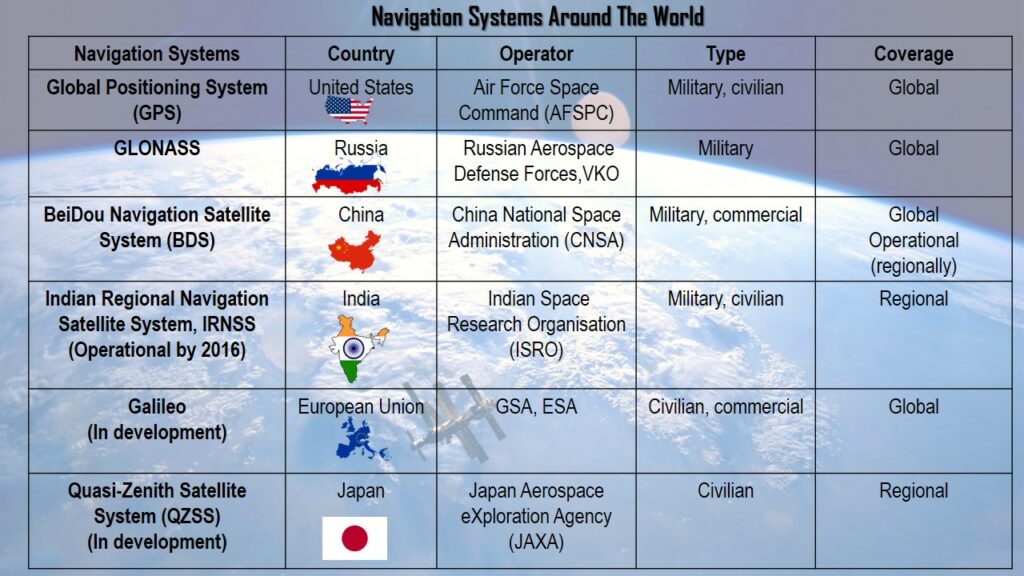
Q. Consider the following statements :
- Ballistic missiles are jet-propelled at subsonic speeds throughout their flights, while cruise missiles are rocket powered only in the initial phase of flight.
- Agni-V is a medium-range supersonic cruise missile, while BrahMos is a solid-fuelled intercontinental ballistic missile.
Which of the statements given above is/are correct?
(a) 1 only
(b) 2 only
(c) Both 1 and 2
(d) Neither 1 nor 2
Answer: (d) Neither 1 nor 2
Notes:
Cruise missiles & Ballistic missiles
- Cruise missiles are jet-propelled at subsonic speeds throughout their flights, while ballistic missiles are rocket-powered only in the initial (boost) phase of flight, after which they follow an arcing trajectory to the target.
- Ballistic Missile
- A ballistic missile follows a ballistic trajectory to deliver one or more warheads on a predetermined target.
- A ballistic trajectory is the path of an object that is launched but has no active propulsion during its actual flight (these weapons are guided only during relatively brief periods of flight).
- Consequently, the trajectory is fully determined by a given initial velocity, effects of gravity, air resistance, and motion of the earth (Coriolis Force).
- Shorter range ballistic missiles stay within the Earth’s atmosphere.
- Longer-ranged intercontinental ballistic missiles (ICBMs), are launched on a sub-orbital flight trajectory and spend most of their flight out of the atmosphere.
- Types of ballistic missiles based on the range
- Short-range (tactical) ballistic missile (SRBM): Range between 300 km and 1,000 km.
- Medium-range (theatre) ballistic missile (MRBM): 1,000 km to 3,500 km.
- Intermediate-range (Long-Range) ballistic missile (IRBM or LRBM): 3,500 km and 5,500 km.
- Intercontinental ballistic missile (ICBM): 5,500 km +
- Cruise missile
- A cruise missile is a guided missile (target has to be pre-set) used against terrestrial targets.
- It remains in the atmosphere throughout its flight.
- It flies the major portion of its flight path at approximately constant speed.
- Cruise missiles are designed to deliver a large warhead over long distances with high precision.
- Modern cruise missiles are capable of travelling at supersonic or high subsonic speeds, are self-navigating, and are able to fly on a non-ballistic, extremely low-altitude trajectory.
- Types of cruise missiles based on speed
- Hypersonic (Mach 5): these missiles would travel at least five times the speed of sound (Mach 5). E.g. BrahMos-II.
- Supersonic (Mach 2-3): these missiles travel faster than the speed of sound. E.g. BrahMos.
- Subsonic (Mach 0.8): these missiles travel slower than the speed of sound. E.g. Nirbhay.
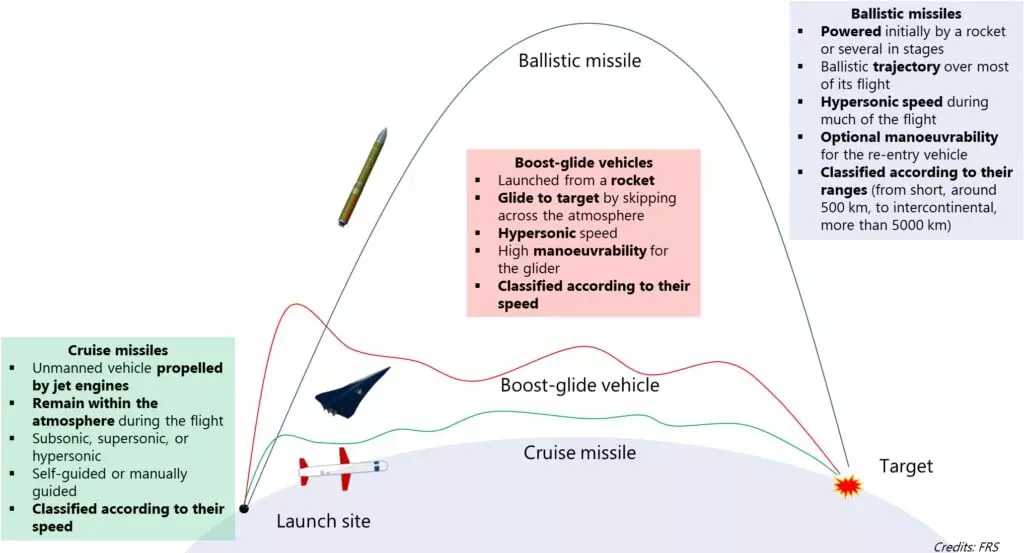
Agni-V & BrahMos
- Agni-V is a ballistic missile while The BrahMos (also designated as PJ-10) is a medium-range ramjet supersonic cruise missile that can be launched from submarine, ships, airplanes or land. The BrahMos is notably the fastest supersonic cruise missile in the world.
- Agni-V
- Agni-5 is an ingeniously built advanced surface-to-surface ballistic missile developed under the Integrated Guided Missile Development Programme (IGMDP).
- It is a fire-and-forget missile, which cannot be stopped without an interceptor missile.
- The missile has the capability of hitting targets beyond the range of 5000 km and is crucial for India’s self-defense systems.
- Agni-1 to 5 missiles are designed & developed by Defence Research and Development Organisation (DRDO).
- Other Ranges of Agni Missiles:
- Agni I: Range of 700-800 km.
- Agni II: Range more than 2000 km.
- Agni III: Range of more than 2,500 Km
- Agni IV: Range is more than 3,500 km and can fire from a road mobile launcher.
- Agni-V: The longest of the Agni series, an Inter-Continental Ballistic Missile (ICBM) with a range of over 5,000 km.
- BrahMos Missile
- The BrahMos missile, an Indo-Russian joint venture, has a range of 290 km and is the fastest cruise missile in the world with a top speed of Mach 2.8 (nearly three times the speed of sound).
- BrahMos is named for the rivers Brahmaputra and Moskva.
- It is a two-stage (solid propellant engine in the first stage and liquid ramjet in second) missile.
- It is a multiplatform missile i.e., it can be launched from land, air, and sea and multi capability missile with pinpoint accuracy that works in both day and night irrespective of the weather conditions.
- It operates on the “Fire and Forgets” principle i.e it does not require further guidance after launch.
- The BrahMos missile, an Indo-Russian joint venture, has a range of 290 km and is the fastest cruise missile in the world with a top speed of Mach 2.8 (nearly three times the speed of sound).

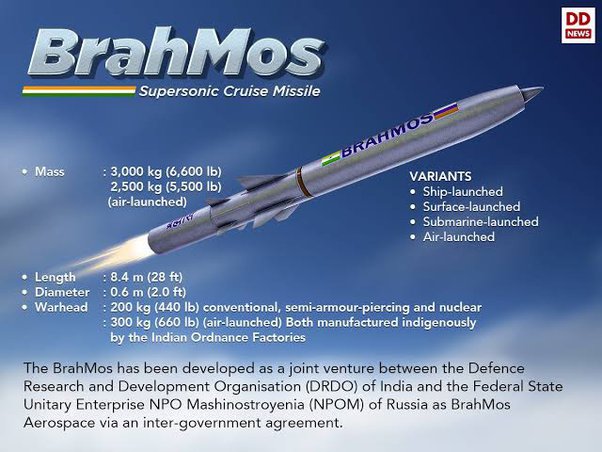
Q. ‘Wolbachia method’ is sometimes talked about with reference to which one of the following?
(a) Controlling the viral diseases spread by mosquitoes
(b) Converting crop residues into packing materia
(c) Producing biodegradable plastics
(d) Producing biochar from. thennochemiceil conversion of biomass
Answer: (a) Controlling the viral diseases spread by mosquitoes
Wolbachia Method
- The “Wolbachia method” is a technique used to control the spread of viral diseases transmitted by mosquitoes, such as dengue, Zika, and chikungunya.
- Wolbachia is a type of bacterium that can be introduced into mosquitoes to reduce their ability to transmit these diseases. When mosquitoes carrying Wolbachia mate with mosquitoes without Wolbachia, the resulting eggs do not hatch or produce offspring, thus reducing the population of disease-carrying mosquitoes.
- In the Wolbachia method, Aedes aegypti mosquitoes are introduced with the bacterium in the lab and then researchers release them into the wild. Now, the Wolbachia-infected mosquitoes breed with their wild counterparts which result in a growing percentage of the bacterium in those mosquitoes. This is known as the Population Replacement Strategy.
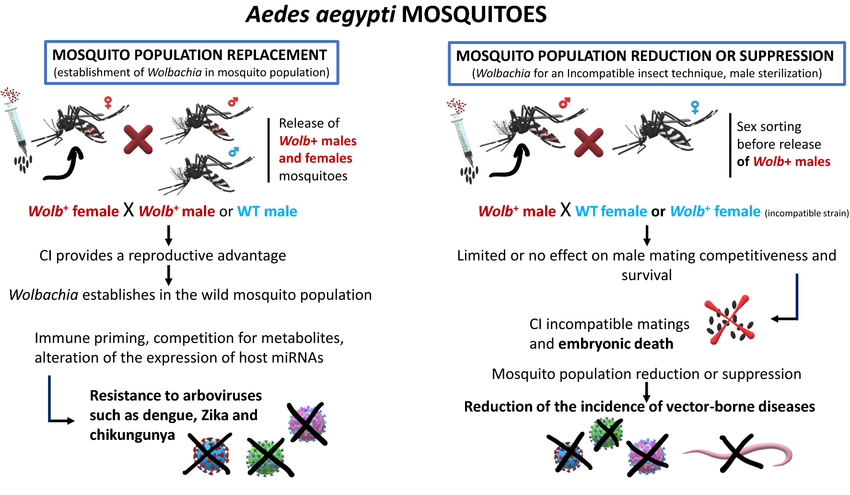

Dengue disease
- According to World Health Organisation (WHO), dengue is a viral infection transmitted to humans through the bite of infected mosquitoes.
- It is a tropical and sub-tropical (climate) disease caused by the dengue virus (Genus Flavivirus) and prime vectors transmitting the disease are Aedes aegypti mosquitoes and, to a lesser extent, Ae. albopictus.
- The mosquito is also responsible for transmitting chikungunya, yellow fever and Zika infection. There is four dengue virus (DENV) serotypes that cause dengue (DEN-1, DEN-2, DEN-3 and DEN-4). Simply put, serotypes means separate groups within a species of microorganisms having a similar characteristic.
Q. Aerial metagenomics’ best refers to which one of the following situations?
(a) Collecting DNA samples from air in a habitat at one go
(b) Understanding the genetic makeup of avian spedes of a habitat
(c) Using air-borne devices collect blood samples from moving animals
(d) Sending drones to inaccessible areas to collect plant and animal samples from land surfaces and water bodies.
Answer: (a) Collecting DNA samples from air in a habitat at one go
Aerial metagenomics
- “Aermal metagenomics” refers to the collection and analysis of DNA samples from the air or aerosol particles present in a specific habitat.
- It involves sampling the air in a particular environment to capture the genetic material (DNA) present in microorganisms, including bacteria, viruses, fungi, and other microscopic organisms.
Q. ‘Microsatellite DNA’ is used in the case of which one of the following?
(a) Studying the evolutionary relationships among various species of fauna
(b) Stimulating ‘stem cells’ to transform into diverse functional tissues
(c) Promoting clonal propagation of horticultural plants
(d) Assessing the efficacy of drugs by conducting series of drug trials in a population
Answer: (a) Studying the evolutionary relationships among various species of fauna
Microsatellite DNA
- Microsatellites, also known as short tandem repeats (STRs) or simple sequence repeats (SSRs), are small regions of repetitive DNA where a specific sequence of 2-6 base pairs is repeated typically 5-50 times. They are found throughout the genome in many organisms, including humans.
- Microsatellites mutate at a high rate, which means they can rapidly change and evolve. Because of this high mutation rate, different individuals and different species often have different numbers of repeats at the same microsatellite location. These differences can be used as genetic markers to distinguish between individuals within a species (for example, in forensic DNA fingerprinting) or to study genetic relationships and evolutionary history among different species.
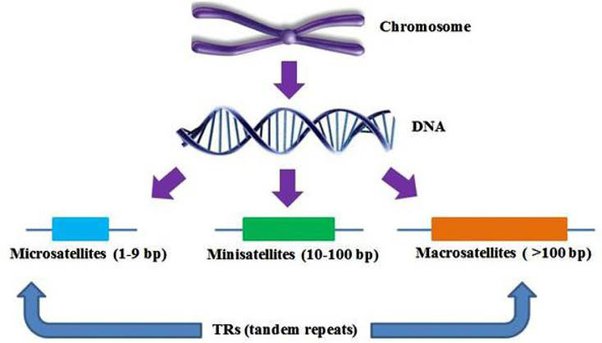
Q. With reference to green hydrogen, consider the following statements :
- It can be used directly as a fuel for internal combustion.
- It can be blended with natural gas and used as fuel for heat or power generation.
- It can be used in the hydrogen full cell to run vehicles.
How many of the above statements are correct?
(a) Only one
(b) Only two
(c) All three
(d) None
Answer: (c) All three
Green hydrogen
- Green hydrogen (GH2 or GH2) is hydrogen generated by renewable energy or from low-carbon power.
- Green hydrogen has significantly lower carbon emissions than grey hydrogen, which is derived from fossil fuels without carbon capture.
- Green hydrogen is a versatile energy carrier that can be used in a variety of applications. It can be used directly as a fuel for internal combustion engines, blended with natural gas and used as fuel for heat or power generation, or used in the hydrogen fuel cell to run vehicles.
- Green hydrogen is produced by the electrolysis of water, using renewable energy sources such as solar or wind power. This means that it is a carbon-free fuel, which can help to reduce greenhouse gas emissions.
- Green hydrogen is still a relatively new technology, but it has the potential to play a significant role in the transition to a clean energy future. It is a clean, efficient, and versatile energy carrier that can be used in a variety of applications.
- Green hydrogen may be used to decarbonize sectors that are hard to electrify, such as cement and iron production. Green hydrogen can be used to produce green ammonia, the main constituent of synthetic fertilizer. It can also be used for long-duration grid energy storage, and for long-duration seasonal energy storage.
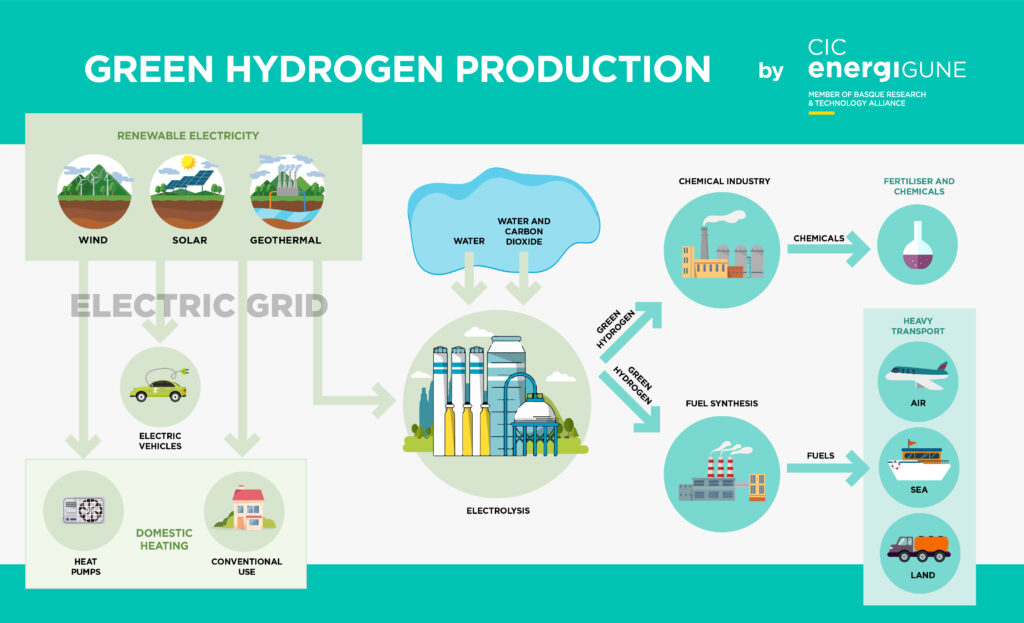
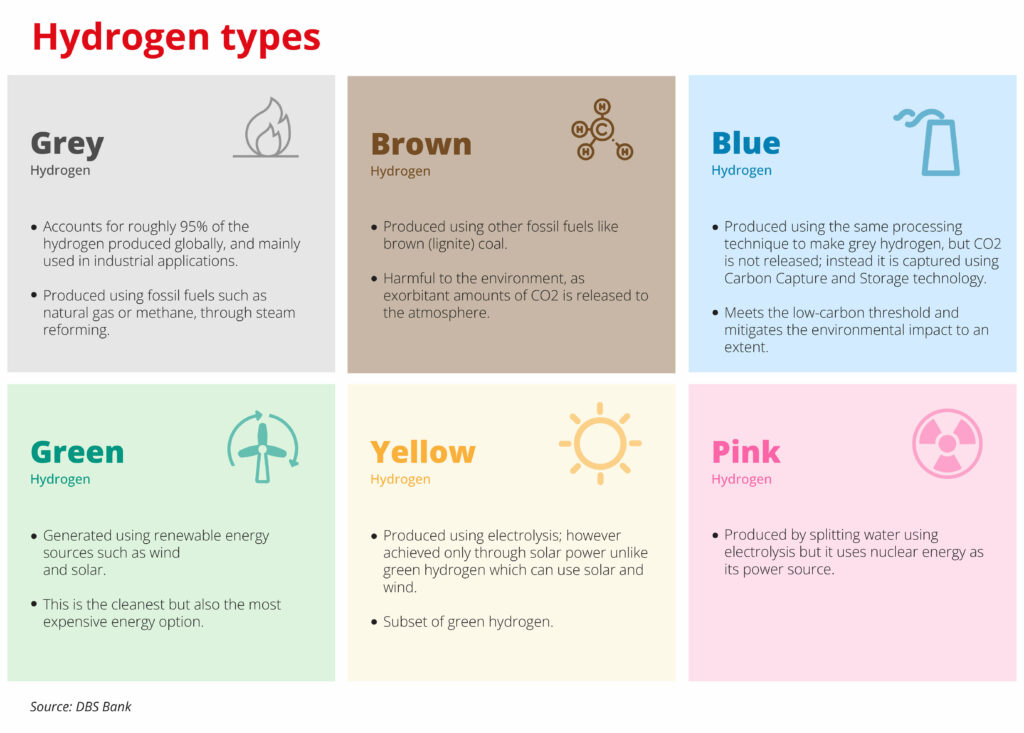
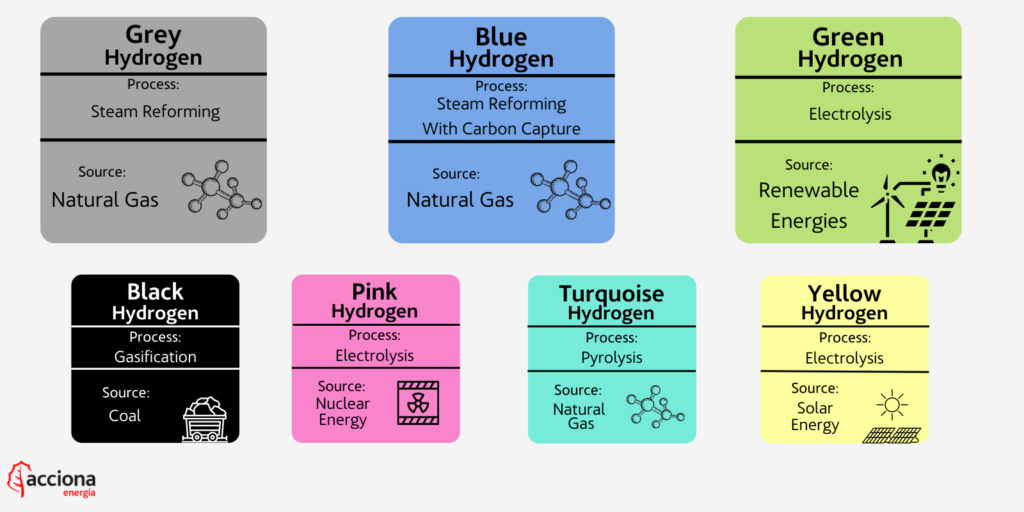
Q. Consider the following :
- Aerosols
- Foam agents
- Fire retardants
- Lubricants
In the making of how many of the above are hydrofluorocarbons used?
(a) Only one
(b) Only two
(c) Only three
(d) All four
Answer: (d) All four
Hydrofluorocarbons (HFCs)
- Hydrofluorocarbons (HFCs) are man-made chemicals that are used in a variety of products, including aerosols, foam agents, fire retardants, and lubricants.
- Hydrofluorocarbons (HFC) are potent greenhouse gases (GHG) that have global warming potentials that range from hundreds to thousands of times that of carbon dioxide. They are the fastest growing GHGs emitted globally, and their use is regulated by the Montreal Protocol on Substances that Deplete the Ozone Layer.
- Under the United Nations Environment Programme’s Montreal Protocol, chlorofluorocarbons and hydrochlorofluorocarbons were recognized as ozone depletion substances (ODS). Hydrofluorocarbons were developed to be substitutes for these ODS; however, HFCs were recognized as potent GHGs.
- Uses:
- Aerosols: HFCs are used as propellants in aerosol cans. They are also used as solvents in aerosol products, such as hairspray and deodorant.
- Foam agents: HFCs are used to make foams, such as polyurethane foam and polystyrene foam. Foams are used in a variety of products, including insulation, packaging, and furniture.
- Fire retardants: HFCs are used to make fire retardants, which are chemicals that are used to slow down or stop the spread of fire. Fire retardants are used in a variety of products, including clothing, furniture, and construction materials.
- Lubricants: HFCs are used to make lubricants, which are substances that are used to reduce friction and wear. Lubricants are used in a variety of products, including engines, gears, and bearings.
- HFCs are also used in a variety of other products, including air conditioners, refrigerators, and freezers.
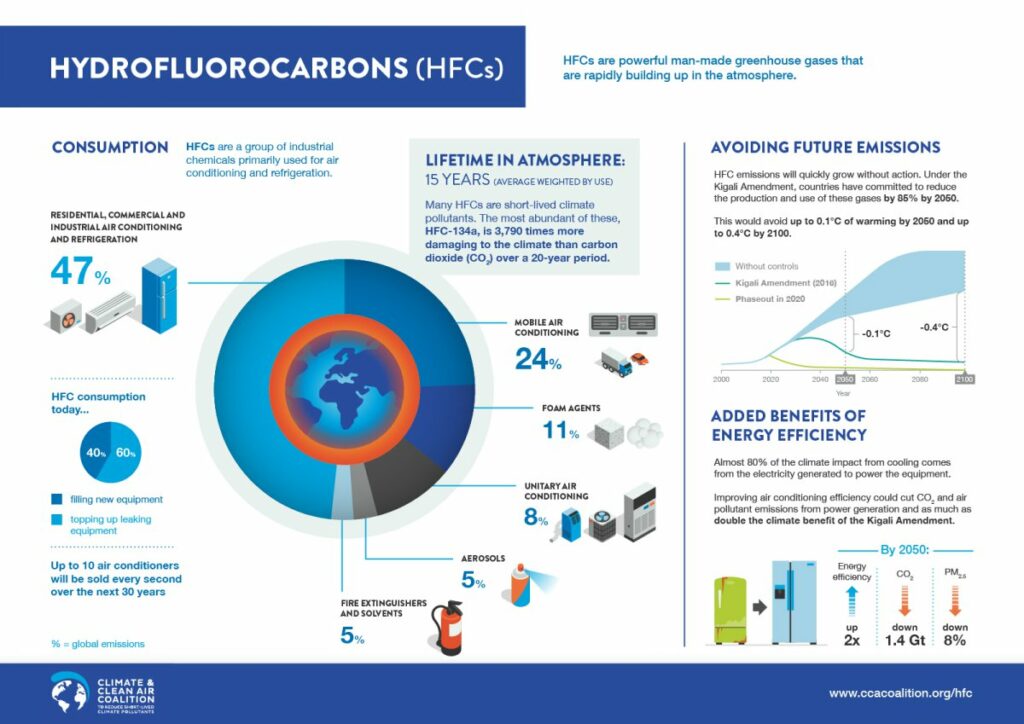
Kigali Agreement
- After coming into force in 1989, the Montreal Protocol has undergone many amendments. The Kigali Amendment is the 8th amendment.
- It happened during the 28th Meeting of Parties when the 197 member countries signed the agreement to amend the Montreal Protocol.
- It is so named because it happened in Kigali, the capital of Rwanda in October 2016.
- According to the terms of the Amendment, the signing countries are expected to decrease the manufacture and usage of hydrofluorocarbons (HFCs) by about 80-85% from their baselines until 2045.
- This will curb global warming (by arresting global average temperature rise to 0.5 degrees Celsius) by the year 2100.
- The Kigali Amendment to the Montreal Protocol on Substances that Deplete the Ozone Layer entered into force on 1st January 2019, following ratification by the required number of countries.
- The agreement aims to phase down HFCs by reducing its manufacture and consumption.
- HFCs are used as replacements for chlorofluorocarbons (CFCs) and hydrochlorofluorocarbons (HCFCs) since they (HFCs) do not have any impact on the depletion of the ozone layer. However, HFCs are powerful greenhouse gases.
- The Montreal Protocol is made even more potent in the fight against greenhouse gases with the Kigali Amendment.
